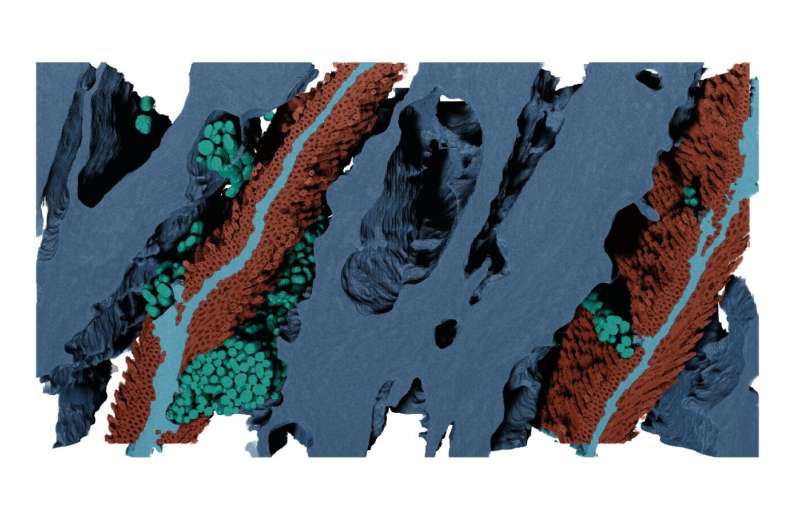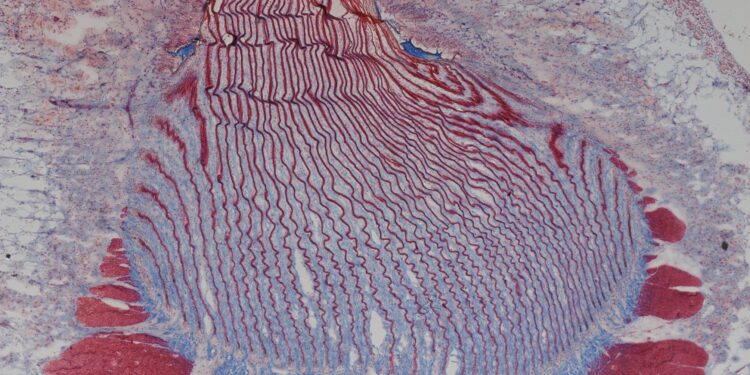Light microscopy image of a histologically stained section of the stem root in which thin wavy leaves of the non-living stem root surrounded by cilia (red) can be seen embedded in the living tissue of the generator (light blue) . Credit: Jenaes Sivasundarampillai
A team of chemists from McGill University, in collaboration with a colleague from Charité-Universitätsmedizin, in Germany, have discovered part of the process used by mussels to bind themselves to rocks and quickly free themselves when conditions warrant. .
In their project, reported in the journal Science, the group studied the interface between mussel tissue and the bundle of filaments that mussels use to anchor themselves to rocks and other objects. Guoqing Pan and Bin Li, of Jiangsu University and Soochow University, both in China, published a Perspective article in the same journal issue describing the team’s work on this new effort.
Mussels are bivalve molluscs that live in both fresh and salt water environments. They have articulated shells connected by a ligament. The muscles ensure a perfect seal when the shell is closed. Mussels use byssus threads (commonly called barbs) to attach themselves to solid objects such as rocks.
Mussel byssus has been widely studied because of its unique ability to connect non-living materials (the filaments that make up threads) to living tissue and disconnect on demand. But, as Pan and Li note, most of this research has focused on possible chemical bonding mechanisms. In this new effort, the research team focused instead on the dynamics of the biointerface.
To better understand how byssus threads connect to living tissue and how they can be dropped if necessary, the research team used various technologies to study the threads and tissues to which they connect. Using several types of imaging as well as spectroscopy, the team observed that the ends of the threads became entangled in layers of living tissue, themselves covered with approximately 6 billion moving cilia.

Features reconstructed in 3D from a stack of FIB-SEM images taken from a small region of the stem root. Living tissue in dark blue, non-living stem root leaf in light blue, secretory vesicles in teal, cilia in red. Credit: Jenaes Sivasundarampillai
They further discovered that having so many cilia resulted in a high degree of surface contact, making it possible to mechanically mesh two disparate materials. The researchers also noted that the oscillations of the cilia helped both strengthen the adhesion between the two materials and allow rapid release when necessary. They found that the movement of the cilia was driven by neurotransmitters, which the researchers said suggests that they are ultimately controlled by serotonin and dopamine.
More information:
Jenaes Sivasundarampillai et al, A strong rapid release biointerface in mussels mediated by serotonergic cilia-based adhesion, Science (2023). DOI: 10.1126/science.adi7401
Guoqing Pan et al, A dynamic biointerface controls mussel adhesion, Science (2023). DOI: 10.1126/science.adl2002
© 2023 Science X Network
Quote: Dynamic bio-interface between mussel tissues and byssus plays an important role in rapid release (November 25, 2023) retrieved November 26, 2023 from
This document is subject to copyright. Except for fair use for private study or research purposes, no part may be reproduced without written permission. The content is provided for information only.



